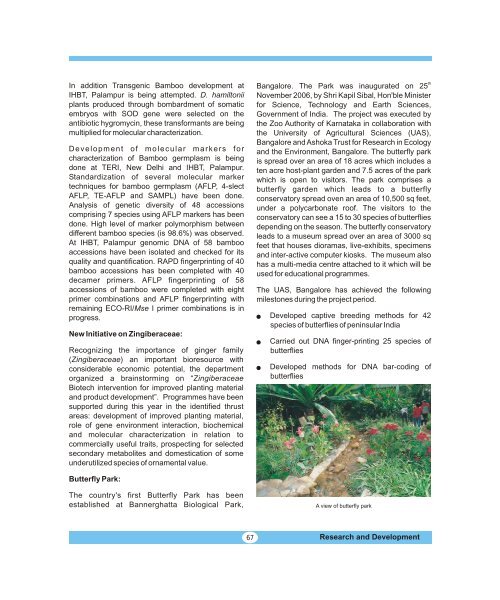ANNUAL REPORT - Department of Biotechnology
ANNUAL REPORT - Department of Biotechnology
ANNUAL REPORT - Department of Biotechnology
Create successful ePaper yourself
Turn your PDF publications into a flip-book with our unique Google optimized e-Paper software.
In addition Transgenic Bamboo development at<br />
IHBT, Palampur is being attempted. D. hamiltonii<br />
plants produced through bombardment <strong>of</strong> somatic<br />
embryos with SOD gene were selected on the<br />
antibiotic hygromycin, these transformants are being<br />
multiplied for molecular characterization.<br />
Development <strong>of</strong> molecular markers for<br />
characterization <strong>of</strong> Bamboo germplasm is being<br />
done at TERI, New Delhi and IHBT, Palampur.<br />
Standardization <strong>of</strong> several molecular marker<br />
techniques for bamboo germplasm (AFLP, 4-slect<br />
AFLP, TE-AFLP and SAMPL) have been done.<br />
Analysis <strong>of</strong> genetic diversity <strong>of</strong> 48 accessions<br />
comprising 7 species using AFLP markers has been<br />
done. High level <strong>of</strong> marker polymorphism between<br />
different bamboo species (is 98.6%) was observed.<br />
At IHBT, Palampur genomic DNA <strong>of</strong> 58 bamboo<br />
accessions have been isolated and checked for its<br />
quality and quantification. RAPD fingerprinting <strong>of</strong> 40<br />
bamboo accessions has been completed with 40<br />
decamer primers. AFLP fingerprinting <strong>of</strong> 58<br />
accessions <strong>of</strong> bamboo were completed with eight<br />
primer combinations and AFLP fingerprinting with<br />
remaining ECO-RI/Mse I primer combinations is in<br />
progress.<br />
New Initiative on Zingiberaceae:<br />
Recognizing the importance <strong>of</strong> ginger family<br />
(Zingiberaceae) an important bioresource with<br />
considerable economic potential, the department<br />
organized a brainstorming on “Zingiberaceae<br />
Biotech intervention for improved planting material<br />
and product development”. Programmes have been<br />
supported during this year in the identified thrust<br />
areas: development <strong>of</strong> improved planting material,<br />
role <strong>of</strong> gene environment interaction, biochemical<br />
and molecular characterization in relation to<br />
commercially useful traits, prospecting for selected<br />
secondary metabolites and domestication <strong>of</strong> some<br />
underutilized species <strong>of</strong> ornamental value.<br />
Butterfly Park:<br />
The country's first Butterfly Park has been<br />
established at Bannerghatta Biological Park,<br />
67<br />
th<br />
Bangalore. The Park was inaugurated on 25<br />
November 2006, by Shri Kapil Sibal, Hon'ble Minister<br />
for Science, Technology and Earth Sciences,<br />
Government <strong>of</strong> India. The project was executed by<br />
the Zoo Authority <strong>of</strong> Karnataka in collaboration with<br />
the University <strong>of</strong> Agricultural Sciences (UAS),<br />
Bangalore and Ashoka Trust for Research in Ecology<br />
and the Environment, Bangalore. The butterfly park<br />
is spread over an area <strong>of</strong> 18 acres which includes a<br />
ten acre host-plant garden and 7.5 acres <strong>of</strong> the park<br />
which is open to visitors. The park comprises a<br />
butterfly garden which leads to a butterfly<br />
conservatory spread oven an area <strong>of</strong> 10,500 sq feet,<br />
under a polycarbonate ro<strong>of</strong>. The visitors to the<br />
conservatory can see a 15 to 30 species <strong>of</strong> butterflies<br />
depending on the season. The butterfly conservatory<br />
leads to a museum spread over an area <strong>of</strong> 3000 sq<br />
feet that houses dioramas, live-exhibits, specimens<br />
and inter-active computer kiosks. The museum also<br />
has a multi-media centre attached to it which will be<br />
used for educational programmes.<br />
The UAS, Bangalore has achieved the following<br />
milestones during the project period.<br />
� Developed captive breeding methods for 42<br />
species <strong>of</strong> butterflies <strong>of</strong> peninsular India<br />
� Carried out DNA finger-printing 25 species <strong>of</strong><br />
butterflies<br />
� Developed methods for DNA bar-coding <strong>of</strong><br />
butterflies<br />
A view <strong>of</strong> butterfly park<br />
Research and Development

















